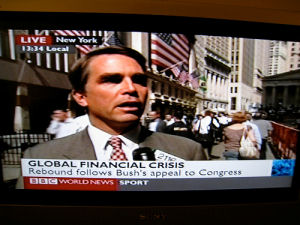 Numerous questions pose themselves for political economists about the crisis – enough (never waste a good crisis) to keep PhDs engaged for a generation. But in my view there are two big picture questions which modern comparative political economy needs to answer. One is why the epicentre of the crisis was in Wall Street and the City of London. The other is this: the crisis occurred as a result of failures in the main regulatory frameworks – the financial and the macroeconomic – which govern much of the workings of advanced economies. Why, in sharp contrast to the 1930s, have these frameworks changed little since the crisis? These questions raise major issues for our understanding of modern capitalism and its relation to the state, as well as the likelihood of another crisis. Marxism offers little guidance – other than alerting us to the importance to the state of those dynamic sectors in which a national economy has comparative advantage.
Numerous questions pose themselves for political economists about the crisis – enough (never waste a good crisis) to keep PhDs engaged for a generation. But in my view there are two big picture questions which modern comparative political economy needs to answer. One is why the epicentre of the crisis was in Wall Street and the City of London. The other is this: the crisis occurred as a result of failures in the main regulatory frameworks – the financial and the macroeconomic – which govern much of the workings of advanced economies. Why, in sharp contrast to the 1930s, have these frameworks changed little since the crisis? These questions raise major issues for our understanding of modern capitalism and its relation to the state, as well as the likelihood of another crisis. Marxism offers little guidance – other than alerting us to the importance to the state of those dynamic sectors in which a national economy has comparative advantage.
1. Why Wall Street and the City?
The modern ‘varieties of capitalism’ literature seeks to explain differences in the comparative sectoral advantages across the different advanced economies. In particular it highlights national differences in the institutional framework in which companies operate, notably governing labour markets, industrial relations and career structures, educational, training and innovation systems, and corporate governance systems and how companies are organised.
Liberal market economies like the US and UK have a ‘comparative institutional advantage’ in economic sectors which require both employees and companies to engage in high risk radical innovation – a hallmark of Wall Street and the City in the last two decades. Institutional preconditions are flexible labour markets, an education and training system with a strong emphasis on high level general education, companies with top down management enabling rapid movement of resources, and a sharp corporate governance system to enforce profitability. These institutions complement each other in the liberal market world of the Anglo-Saxon economies, Ireland and Israel.
But the varieties literature doesn’t go the whole way. Why are there no great high-risk financial centres in Canada or New Zealand, or Ireland or Israel? A rapidly growing area bridging political economy and economics is the political economy of geography. High-risk activities need agglomerations of companies, so that labour mobility is neither too costly to employee
or to company. Agglomerations are a key concept in economic geography. They force us into history and path-dependency and tipping points: at some moment in history, the network economies of Wall Street or the City became too attractive to new entrants and existing high level financial institutions for them to seek to locate elsewhere. A tipping point had been passed, and their current dominance had become path-dependent.
2. The key regulatory systems: why so little change post-crisis?
Turn to the second question. The regulatory system most implicated in the crisis is that governing the operation of financial markets and leveraged financial institutions. The next most implicated is the macroeconomic regulatory system, governing the management of aggregate demand through fiscal and monetary policy to control inflation and unemployment.
The financial regulatory system operates de facto on a national basis monitoring major financial institutions operating within the national territory, deciding on detailed rules and interpretations governing inter alia the definition of riskiness of assets, the computation of capital, on and off balance sheet items and so on; it also in principle takes a view of the systemic risks which may arise within the national financial system. There is some agreement that these systems failed in the UK and the US. The American regulatory system, with the British system not far behind, allowed major investment banks to move to very high levels of leverage; if off balance-sheet items were correctly assessed and if dubious accounting practices corrected, the leverage levels were higher still. At very high leverage the possibility of bankruptcy given a major adverse expectational shift is non-negligible. Moreover, these leverage levels took the assessment of rating agencies and credit default swaps (‘insurance’ against loan and other defaults) at their face value. This made sense if systemic risk was discounted; but the relevant UK and US regulatory agencies (de facto, the SEC, the Fed, the FSA and the Bank of England) did not pick this up in a timely way; the BIS in Basel was more sensitive to this possibility but it had little influence.
As is well known these high leverage levels were massively reinforced by global imbalances. External US/UK deficits allowed private sector dissaving, generating a high demand for risky assets (loans to households); and the corresponding net saving in the exporting countries was invested in the US and the UK and enabled the financing of the risky assets – the other side of the coin. Global imbalances were permitted by the system of macroeconomic regulation. ‘Inflation targeting’ summarises the system widely adopted in the last two decades on a nation-by-nation basis, involving independent central banks using interest rates to keep inflation at a target level in the framework of a New Keynesian macroeconomic model. International coordination plays no role in inflation targeting; there are no requirements on external imbalances; indeed, external imbalances and the real exchange rate are technically jointly determined by aggregate demand – for example a tough fiscal policy, reducing aggregate demand, implies ceteris paribus an external surplus. It contrasts to Bretton Woods, where fundamental disequilibria had to be corrected.
Thus the key national financial regulatory systems allowed major financial institutions extraordinarily high leverage and did not have the means to monitor the possibility of systemic collapse in the US and the UK. And the national systems of acroeconomic regulation – in the exporting countries (Germany and Northern Europe in EMU and Japan, as well of course as China with more dirigiste macroeconomic management) – allowed the development of (massive) global imbalances which ratcheted up this possibility. But since the crisis the inflation targeting systems have hardly changed. And while there has been tightening of banking rules, this has taken place in Martin Wolf’s terms ‘within the pre-existing intellectual and institutional framework’; in particular, national regulators remain responsible for interpretation, monitoring and sanctioning.
The answer we believe lies in rethinking the relation of national governments and capitalism, in both the advanced world and in developmental states like China. National governments are deeply concerned about promoting high value added economic sectors, especially those where the value added comes from human capital. These sectors, in a ‘knowledge economy’ world, provide the drivers for national innovation, for links between universities and the private sector and for higher-level education and training, as well as well-paid employment and tax revenue. This typically does not reflect partisan considerations. Were these sectors the same across the different advanced countries, one might have expected a common public or private supranational regulatory system. But different varieties of capitalism generate comparative advantages for different high value added sectors: as we have seen, high risk high innovation financial sectors are located in Liberal Market Economies (as well as many other business service sectors, commercial law, and also biotech, blockbuster software, and radical innovation in electronics). It is no surprise that the US and the UK should want to retain control of financial regulatory systems to ensure that risk-taking and innovation is not stifled; this was as much Clinton and Blair’s concern as it was that of Bush or Thatcher – who started much of this off with the Big Bang. By contrast, the comparative advantage of German or Scandinavian capitalism is in the export of a great range of highly specialised goods and services, benefitting from strong vocational training and technology transfer as well as experienced and cooperative workforces, underpinned by block shareholding. In part because human capital in these high quality sectors is deep and specific, so needs to be used to the full in exporting; in part because there are typically strong positive externalities to training and innovation systems from increased exports; in part because a tight fiscal policy constrains wage demands in the public sector from undermining restraint of export sector unions: these countries, as well as Japan and China for similar reasons, want no constraints on their exports through macroeconomic regulatory rules pressuring them to expand consumer demand.
Analysing the modern world requires understanding the deep concerns of the governments of advanced nations for their high value added sectors, hence their concern to retain control of relevant regulatory systems. Their success in doing so, as in nurturing their high value added sectors, may explain why – despite three decades of globalisation – these governments dominate world politics.
This article is based on work with Peter A Hall and Torben Iversen, who both teach Government at Harvard. To read more see Peter A Hall and David Soskice, Varieties of Capitalism (OUP 2001). Peter Hall completed the MPhil in Politics at Balliol in 1974. The article was first published in the Inspires alumni magazine, issue one, Trinity Term 2011, pp. 14-15.
David Soskice is Research Professor of Comparative Political Economy, and Senior Research Fellow, Nuffield College.
(Photograph courtesy of Tristan Nitot.)





No Comment